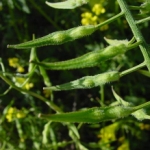| Common Name: |
White Mustard |
| Botanical Name: |
Sinapsis alba syn. Brassica alba, B. hirta |
| Genus: |
Sinapsis |
| Family: |
Brassicaceae |
| Native Location: |
Mediterranean and Near East; widely naturalized. |
| Cultivation: |
Moist soil in sun. |
| Propagation: |
By seed sown in spring. |
| Harvest: |
Seeds are harvested as they ripen, dried, and stored whole, ground, or crushed for oil. |
| Height: |
60-80cm (24-32in) |
| :Width |
30cm (12in) |
| Hardiness: |
Hardy |
| Parts Used: |
Seeds (bai jie zi), oil |
| Properties: |
A pungent, stimulant, warming herb that improved digestion and circulation, relieves pain, and is expectorant, diuretic, and antibiotic. |
| Medicinal Uses: |
Externally (usually in mustard bandages, baths, or poultices) for respiratory infections, arthritic joints, chilblains, and skin eruptions. In traditional Chinese medicine, for complaints characterized by cold and torpor; internally for bronchial congestion, coughs and joint pains; externally for painful extremities, neuralgia, sprains, sores, boils, and bruises. |
| Culinary Uses: |
Ground seeds provide the basis for mustards to accompany meats. Whole seeds are an important component of pickles. Seeds are sprouted with those of Lepidium sativum (See, Cress) as "mustard and cress"; the mustard seeds grow more quickly than the cress, so are sown three days later. |
| Warning: |
Like other mustards, seeds of S. alba contain substances that are extremely irritant to the skin and mucous membranes.
For use by qualified practioners only. |
| Bibliography: |
Encylopedia of Herbs by Deni Brown Copyright ©: 1995, 2001 Dorling Kindersley Limited pg 369
|

